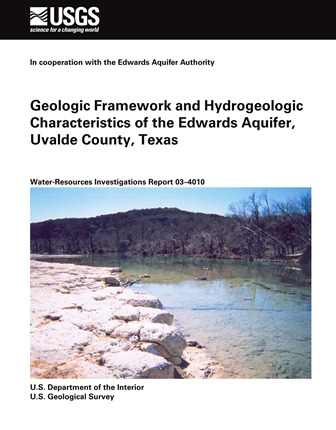Geologic Framework and Hydrogeologic Characteristics of the Edwards Aquifer, Uvalde County, Texas

| Summary |
|
The Edwards aquifer in Uvalde County is composed of Lower Cretaceous carbonate (mostly dolomitic limestone) strata of the Devils River Formation in the Devils River trend and of the West Nueces, McKnight, and Salmon Peak Formations in the Maverick basin. Rocks in the Devils River trend are divided at the bottom of the Devils River Formation into the (informal) basal nodular unit. Maverick basin rocks are divided (informally) into the basal nodular unit of the West Nueces Formation; into lower, middle, and upper units of the McKnight Formation; and into lower and upper units of the Salmon Peak Formation. The Edwards aquifer overlies the (Lower Cretaceous) Glen Rose Limestone, which composes the lower confining unit of the Edwards aquifer. The Edwards aquifer is overlain by the (Upper Cretaceous) Del Rio Clay, the basal formation of the upper confining unit. Upper Cretaceous and (or) Lower Tertiary igneous rocks intrude all stratigraphic units that compose the Edwards aquifer, particularly in the southern part of the study area. The Balcones fault zone and the Uvalde salient are the principal structural features in the study area. The fault zone comprises mostly en echelon, high-angle, and down-to-the-southeast normal faults that trend mostly from southwest to northeast. The Uvalde salient—resulting apparently from a combination of crustal uplift, diverse faulting, and igneous activity—elevates the Edwards aquifer to the surface across the central part of Uvalde County. Downfaulted blocks associated with six primary faults—Cooks, Black Mountain, Blue Mountain, Uvalde, Agape, and Connor—juxtapose the Salmon Peak Formation (Lower Cretaceous) in central parts of the study area against Upper Cretaceous strata in the southeastern part. The carbonate rocks of the Devils River trend and the Maverick basin are products of assorted tectonic and depositional conditions that affected the depth and circulation of the Cretaceous seas. The Devils River Formation formed in a fringing carbonate bank—the Devils River trend—in mostly open shallow marine environments of relatively high wave and current energy. The West Nueces, McKnight, and Salmon Peak Formations resulted mostly from partly restricted to open marine, tidal-flat, and restricted deep-basinal environments in the Maverick basin. The porosity of the Edwards aquifer results from depositional and diagenetic effects along specific lithostratigraphic horizons (fabric selective) and from structural and solutional features that can occur in any lithostratigraphic horizon (non-fabric selective). In addition to porosity depending upon the effects of fracturing and the dissolution of chemically unstable (soluble) minerals and fossils, the resultant permeability depends on the size, shape, and distribution of the porosity as well as the interconnection among the pores. Upper parts of the Devils River Formation and the upper unit of the Salmon Peak Formation compose some of the most porous and permeable rocks in Uvalde County. |
Search for Documents
Advance Search
Explore EAA's Scientific Reports
- All Reports
- Groundwater Recharge, Recharge Zone
- Groundwater Movement
- Geomorphology and Caves
- Weather Modification
- Geology
- Water Use and Conservation
- Geochemistry
- Water Resources Planning and Management
- Floods and Drought
- Water Quality
- Climatology
- Surface Water / Groundwater Relationship
- Biology
- Springs, Groundwater Discharge
- Archaeology
- RZ Protection
- Aquifer Levels
- Remote Sensing
- Precipitation
- Overview Studies
- Modeling
- Hydrology and Hydrogeology
- History
